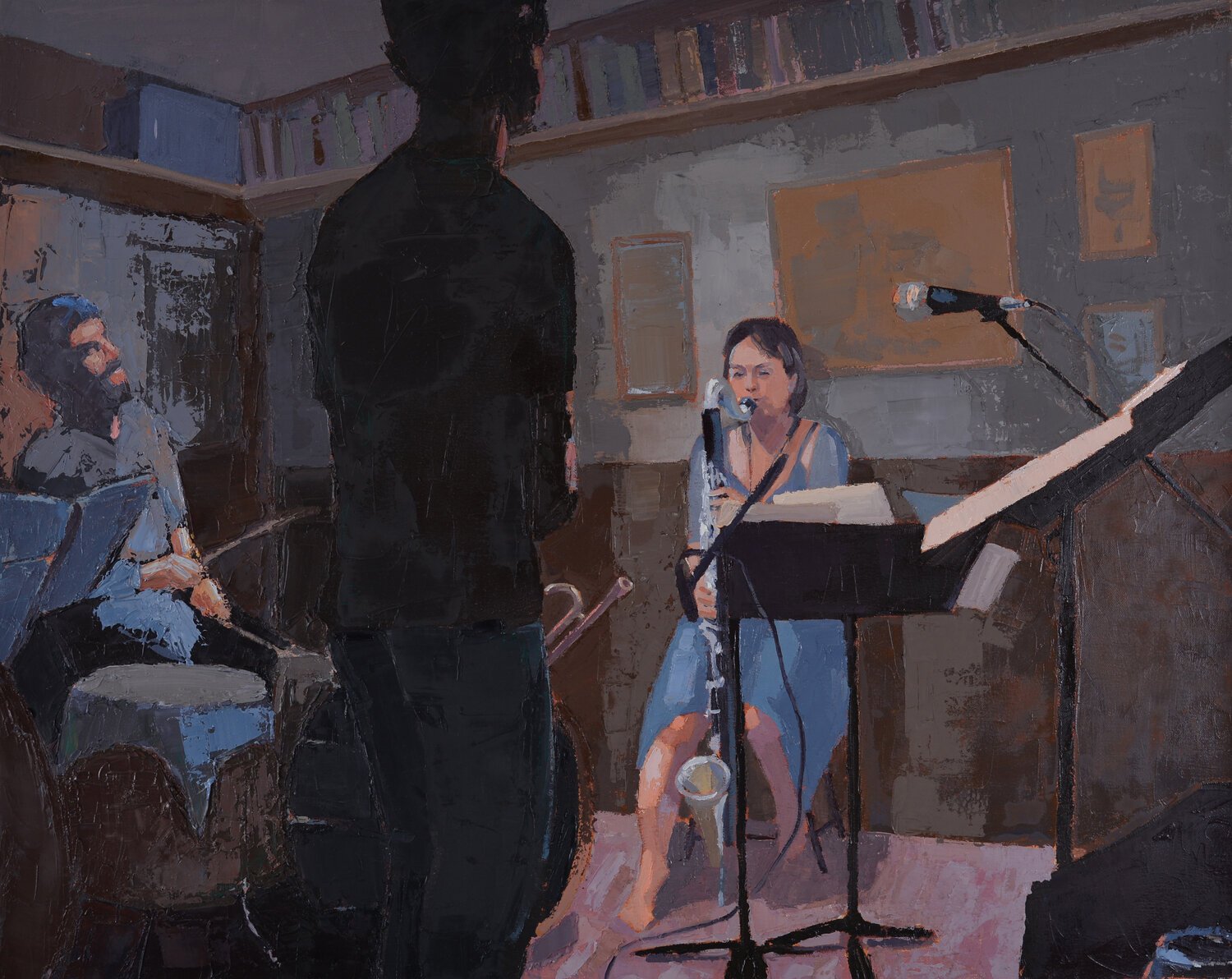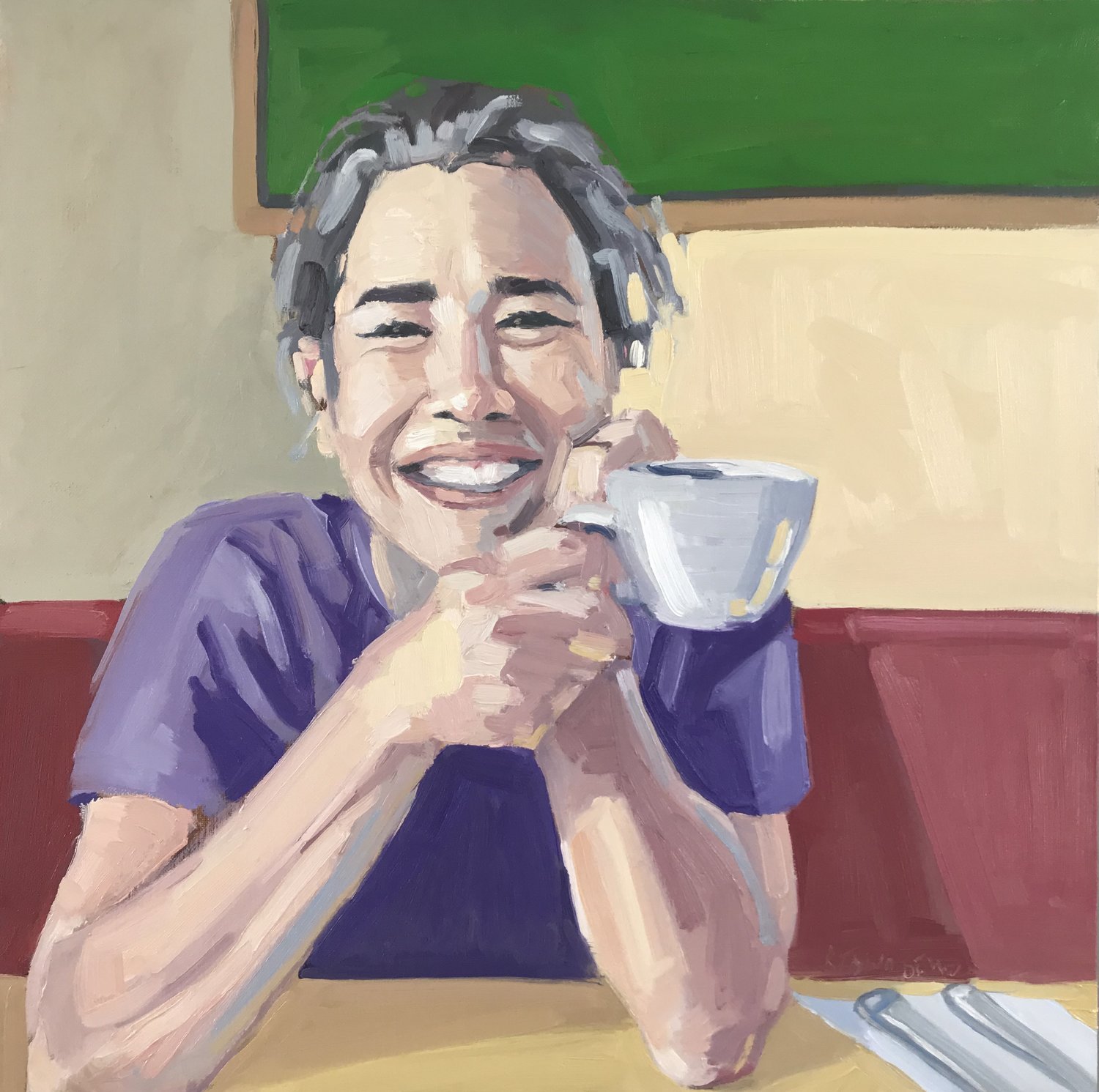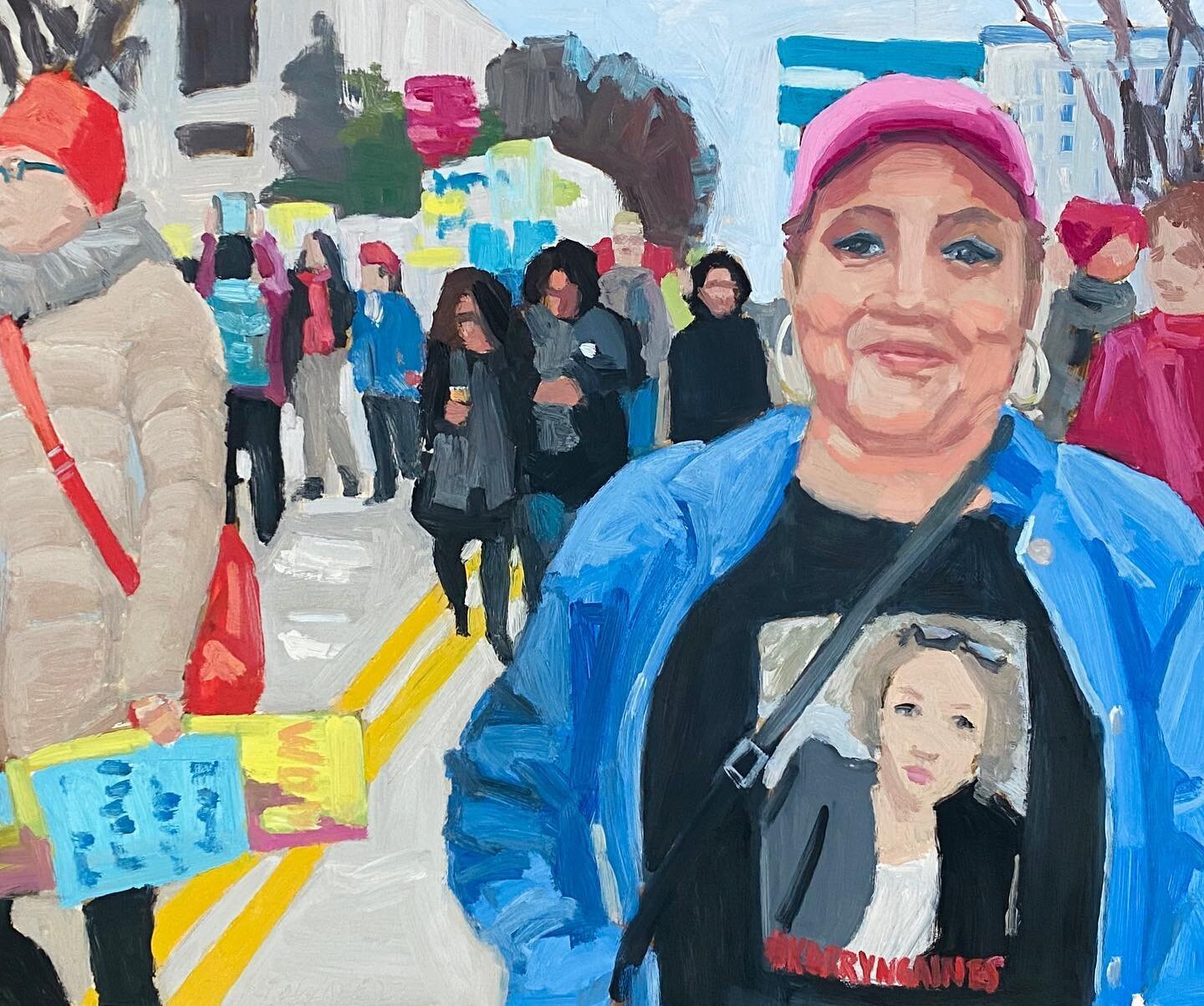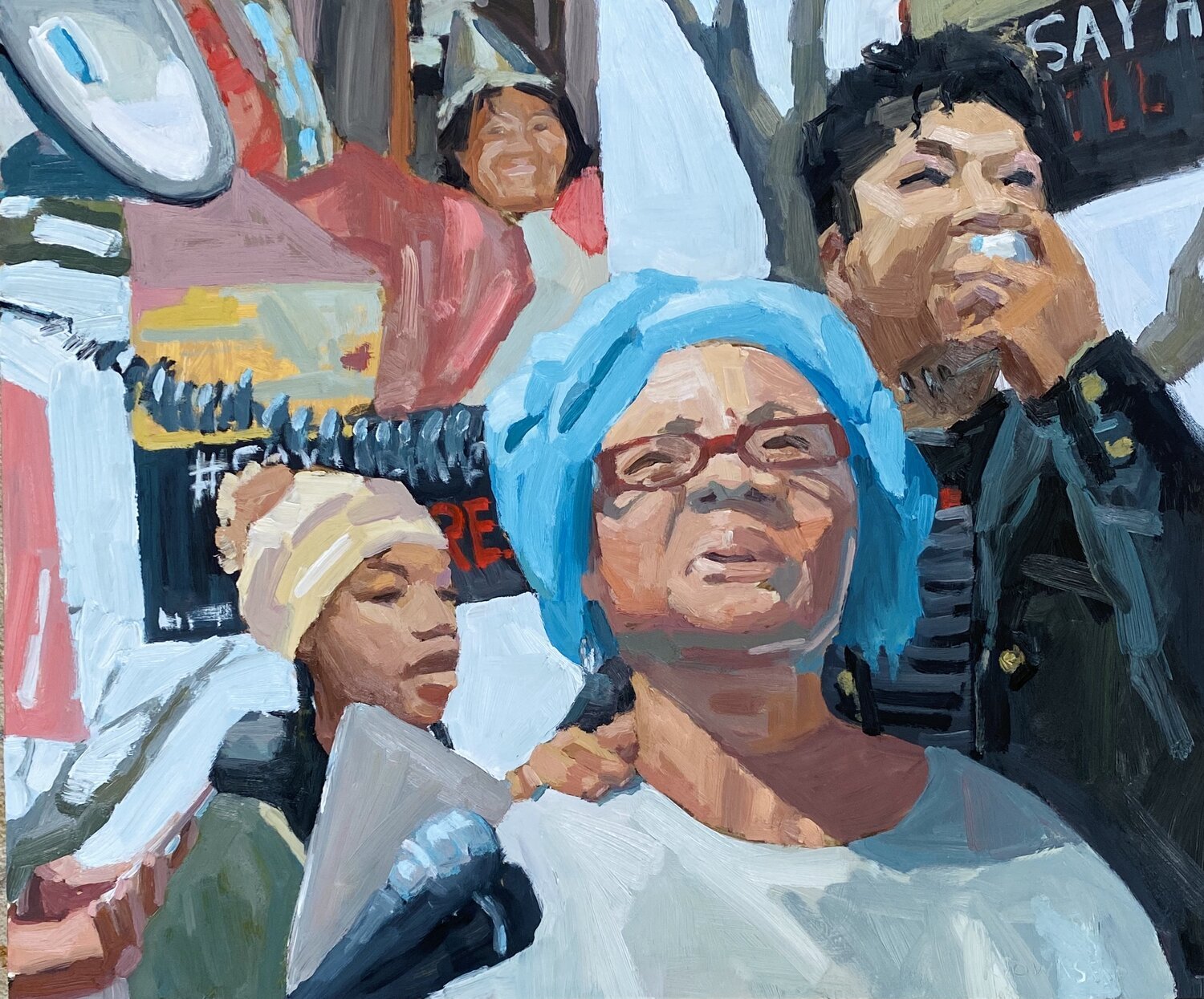Exhibition
The Art of BEING a HERo
2020 Beverly Street Studio School Gallery, Staunton, VA
2020 Oxeye Vineyard, Staunton, VA
2019 McGuffey Art Center, Charlottesville, VA
“Strong women are everywhere. Listen to them. Respect them. Support them. And they will change the world.”
— KRISTA TOWNSEND
Why I Created This Work
I started this series of paintings of strong women as a way to process and respond to our political atmosphere. On January 21, 2017, my step daughter and I, my sister and her daughter, and a handful of close women friends marched with thousands of others in the Women’s March on Washington. It was extremely inspirational, and I wanted to do more. So I used what I know as a form of expression and exploration, and I painted.
I started by painting my friend Tori in her Jujitsu Gi in a pose of power. Then my friend April copying the pose and outfit of the Uncle Sam posters of the past. I loved painting these strong women in strong poses, but slowly I began paying attention to the more subtle aspects of my friends’ strength. I found that even more intriguing to paint because many of them were quite shy about me painting them in the first place. I wanted to take what I saw as their strengths and show it to them as well as to the public who may see my work in an exhibition.
I’ve been so thrilled by the response! This is the third time this show is being exhibited. And one of the paintings was selected to be in an exhibition at the Taubman Museum of Art in Roanoke, VA.
This exhibition of the show features some new work. Women I don’t know, but have found through social media related to recent protests. I’ve been so moved by the work of the women in the #SayHerName campaign of the African American Policy Forum (AAPF), that I decided to ask them if I could paint them. I was able to make contact with 2 of the 3 women I painted and they were excited at the honor of being painted. I’ve also decided to donate all of my proceeds from the sale of any work from this show to the AAPF.
I am grateful for the work in The Art of Being a Hero because its offered me a way of processing, but I also hope that creating this work and honoring these strong women may inspire and motivate people to support each other’s strength and speak up for our rights.
Read a review of the initial exhibition from Charlottesville’s Daily Progress
Krista and this show are also featured as part of “In Charlottesville, Artists Disagree on How — or If — Art Can Heal the City’s Wounds”
Review | Krista Townsend's new paintings at McGuffey explore strength in diverse forms
Jane Sathe
Oct 23, 2019
View the article in the Daily Progress >
Strength doesn’t have to be about barbells and bombast. Sometimes, it’s the moment when a perceptive 13-year-old begins to grasp the realities of homelessness through a more adult perspective.
It can live in lifelong friendships that keep women confident and secure through decades of marriage, work, childrearing and grandparenting, building each other up as they check in and chat at a kitchen table. And it can be the moment when a hard-working woman acknowledges the necessity of self-care by sneaking in an afternoon nap.
The women in the paintings in “The Art of BEING a HERo,” Krista Townsend’s current exhibition at McGuffey Art Center, reveal their strength in different ways. One poses in a vivid blue evening gown with her arm around her beloved pit bull. Another woman, in the first portrait Townsend painted for the series, stands ready for action in a crisp white gi closed by a Brazilian jiu-jitsu brown belt. Yet another, comfortable in her own skin as a breast cancer survivor, teacher, student and busy mother, beams over a coffee cup.
Townsend began painting unconventional portraits of inspiring women in her life soon after the Supreme Court confirmation hearings for Brett Kavanaugh. Current events were bringing an intensifying stream of moments that troubled her — everything from painful stories shared in in the Me Too movement to the tragic consequences of the violent rallies of Aug. 11-12, 2017. As she tried to make sense of events unfolding in the city and the country, she began listening to progressive podcasts while working in her studio — “and getting pretty fired up,” she said.
“I was listening while I was painting, and landscapes were just not doing it for me,” Townsend said.
“I just started looking around at the women I know, and I wanted to paint that vision of in-your-face strength — but also the quiet strength that many of us have as we go through life day by day and take care of others.”
Townsend began to notice many different varieties and intensities of strength and yearned to capture them.
“Finding Her Way,” which shows Townsend’s normally outgoing 13-year-old stepdaughter in a reflective moment on a train during a visit to New York City, captures “that trepidation of teenagerhood,” Townsend said. “She’s having a cultural awakening about what people go through.”
Several works depict women who draw strength from the natural world while tending plants, growing their own food and climbing rocks. One friend shown among huge elephant leaves in her front-yard garden surprised Townsend with her willingness to pose nude. Others are captured in interior spheres that reflect a sense of centering and restoration, from a family library in a 150-year-old house to the kitchen table of Townsend’s mother to the quiet room that serves as a busy lawyer’s retreat.
“I didn’t necessarily explain to each of the women why I had chosen to depict them the way I did,” Townsend said. “I don’t think they necessarily saw what I saw. We aren’t as good, or as trained, at saying, ‘Yeah, I’m really good at that.’’’
The exhibition gives people a chance to pause, reflect and think about the people in their own lives, noticing strength in moments outside customary depictions.
“Showing vulnerability is something women have in a way that men don’t always have access to,” Townsend said. “I think this country needs a mother.”
“Part of my process is how I got to the more subtle strength,” Townsend said. That’s part of why the former McGuffey Art Center member chose McGuffey as the location for this show.
“It’s a community place, and people walk through it,” she said. “It’s more about people seeing it, and the intention.”
As Townsend looked at the women in her life with new eyes, she began to see the value of “just putting this body of work out there and saying, ‘This is what I see.’’’
And the process has helped her find a new world of artistic possibilities in strengths of her own.
“I don’t think I can go back to landscapes now,” she said.
The Work
THEY TRIED TO BURY US, THEY DIDN’T KNOW WE WERE SEEDS
Like all the women I am painting, there are so many reasons that I admire her. The most recent and politically impactful is that while protesting the white nationalist — Nazi — descent upon our city of Charlottesville, VA, on August 12, 2017, she was almost run over when a man drove his car full-speed through a crowd of people, killing one and physically injuring over 20. She was lucky to not be physically hurt, but the emotional impact has been great and she has fought hard to regain her normal day-to-day. Her strength led her down the path of self-care and seeking others who shared her experience. It also led her to increase her activism and lean into the forces that hurt her. She continues to protest and fight for what she believes in. She walked hundreds of miles from Charlottesville to Washington, DC to protest white supremacy. She belongs to local organizations and regularly attends local political efforts to move our country forward, for example, to finally ratify the ERA. Before all of this happened, she volunteered for the Peace Corps and spend two years in Africa much later in life than most, learning not one but two languages to do so.
The phrase “They Tried To Bury Us, They Didn’t Know We Were Seeds” has a long history going back to an Ancient Greek poem, but can be traced, more recently, to Mexican activists who used it in support of the Ayotzinapa 43 — 43 students who disappeared in Iguala, Mexico in 2013. The statement has also been used in the current protest of how the United States is handling immigration in the Trump era. I used these words in this work because they directly connect to Mexico and immigration and this strong woman comes from a family of immigrants on her father’s side from Mexico. In addition, the metaphor of seeds offers the idea that those who have suffered immensely might help bear the fruits of justice later on.
THE KITCHEN OF MY CHILDHOOD
This painting is of my mom and her two best friends, who have been second moms to me growing up. This kitchen and these women have a special place in my heart and in my memories. Between the three of them, they have raised seven daughters and one son. They now have twelve grandchildren. We’ve all been blessed with directly witnessing the power that bonds close female friendships. They taught us how to be confident, where to find our own strength, and how to love and take care of ourselves and others. Plus, they are smart, sassy, and very funny. The greatest heroes have to have a good sense of humor!
NOLITE TE BASTARDES CARBORUNDORUM, BITCHES
She is smart as a whip, and though she is endearingly, outwardly untidy, her ability to organize her thoughts, speak dynamically in front of a room of people, and remember facts and decisions is spot on. This was painted when she is was a brown belt in Brazilian Jiu-jitsu, but since then she’s gotten her black belt. She’s also a leader and teacher at her local jiu-jitsu academy, and she organizes and teaches self-defense workshops to women in the community.
None of this is even her job – where she leads a large team of people who facilitate the communication of cutting-edge scientific research that helps save lives around the world.
This was the first painting that I did in this series. I was pretty fired up at the time and wanted to create a confrontational documentation of the very outwardly obvious versions of strength. I chose the title to match. “Nolite te Bastardes Carborundorum, Bitches” comes from the recent TV adaptation of Margaret Atwood’s dystopian novel The Handmaid’s Tale. Though the phrase is technically made-up Latin, it has taken on a life of its own, as a sort of feminist rallying cry. These words mean “don’t let the bastards grind you down” in the novel. The TV series adds a modern twist with “Bitches” directing the statement outwardly and globally instead of inwardly and singularly. It also adds confrontation and camaraderie, both of which I think is needed these days. Women are often considered bitches when they are aggressive, the exact opposite of how men are regarded when they push for what they want. These words represent both the personal battles of this woman and her unflinching leadership in the work-place and on the jiu-jitsu mat. She is steadfast in all aspects of her life against varying voices that say she can’t or she’s wasting her time.
HER SPACE
This painting was the turning point in this series when I started to explore more subtle expressions of strength.
I’ve always admired the care that she takes of herself, her home, and her dogs (though you can’t see them in this painting, they are just beyond view for sure). To me that demonstrates her strength. She splits her time between the countryside of central Virginia and Washington, D.C. She works in a law firm in D.C. where she sometimes finds herself drained by the energy required to do what she does. So she has created a peaceful second home in the country where she can re-energize. Her space is very important to her and I think that knowing and caring for yourself is so important. If we don’t care for ourselves, how can we care for others?
FINDING HER WAY
This is my stepdaughter. She’s a bubbly, energetic, outgoing, extrovert who, even as she begins the broody teenage years, usually has a smile on her face. This scene, however, captures a moment of trepidation. We’ve travelled to New York city many times with her, but this time, she started to see things adults see. She noticed the homeless people in Grand Central Station. She experienced the discomfort of people asking for money. She really saw poverty for the first time. At the same time, she was old enough to have a little more independence and try a few things solo while in the city. The painting aims to depict the desire for independence that she, as a teenager has, while also showing the anxiety that comes along with growing up. In the reflection on the left, you see her father who is and always will be there for her when she needs it, but is doing his best to let her grow up.
SUMMER GARDEN
I had the idea to paint this woman among the elephant leaves of her front garden. Not because it was a specific symbol of strength but to my surprise it turned out to be. She offered me the chance to do a more traditional figure painting by unabashedly letting me paint her in the nude! Her lack of modesty especially with this being in front of her house where passersby may have seen her, was awesome! She is an inspiration in her willingness to participate in this project with me not once but twice. Her generosity and openness remind me of when we first met. I’d just moved to town and didn’t know many people. I signed up for a CSA that she managed and when I went to my first pick up, I thought she was so nice and so I asked her if she’d be my friend! It’s not my normal approach to making friends but she was just so approachable and kind to a new person in town. And sure enough, she did become one of my best friends. That was 13 years ago! In my opinion, the kindness and openness that she exudes in her daily life is a big part of her strength.
EXPLORING
Every time I see this woman, she’s just returned from an amazing trip seeing and experiencing the world. She also travels for work as a landscape architect doing work for National Parks as well as local community park projects. She cares deeply for our world, this country and her home town and this is most apparent to me in the political conversations we often end up having. We’ve started meeting frequently with a group of friends to process all that is going on and figure out what we as citizens can do to help make positive change. Just knowing that we have each other is motivation to keep our chins up, get involved, write or call our representatives, to just participate in the process. I appreciate so much being able to do this with her.
IMPROVISATION
“People intoxicate themselves with work so they won't see how they really are.”
”Next to silence, that which expresses the inexpressible is music.”
These two quotes by Aldous Huxley are favorites of Michelle’s and say a lot about who she is. She plays the bass clarinet like a bad ass! She studied music at the Manhattan School of Music but did not make music her career. I understand that. Sometimes something is such a part of who you are that you don’t want to make it “work”. So instead it’s how she plays! Her work is equally impressive though. She’s worked in the Peace Corps and for non-profits in Africa. She told me a story about having helped set up a radio station in an African village and how important that technology was to helping people communicate and know what is going on in their country and the world. Now she runs her own business as an Executive Coach & Organizational Development Consultant.
RESEARCHING
This woman is a Professor of Public Policy and Politics and the Director of Social Entrepreneurship at the University of Virginia. She studies social justice advocacy, activism and direct action through social entrepreneurship. She’s published two books and many articles and has traveled the world doing her research. Most recently, she traveled to Mexico to work with refugees as our country continues to block entry and imprison people fleeing unbearable situations in their home countries. Our country and world need people like her and our community is lucky to have her.
COFFEE BREAK
I can’t recall a time when Christa was without a smile, though she always has so much on her plate! Taking this break was probably brief as she was probably running off to study for her Master’s Degree in teaching, or to drop one of her three children someplace… that would be the three children she raises all by herself! Or she was probably about to run off to teach or do Kung Fu or to teach special education in the public school system. Our community is certainly lucky to have this woman who is so passionate about teaching!
She’s also a breast cancer survivor and though it takes a lot of strength of character and will to keep going through an illness like that, it’s not what I find most amazing about her story. I have always been so awed that she opted not to have reconstructive surgery. She has embraced the shape of her body with its changes. I think she’s beautiful especially because she is proud of who she is and lets her scars tell her story, instead of trying to fit into what society thinks the female form should look like.
#SAYHERNAME 2, RHANDA DORMEUS
This is Rhanda Dormeus, mother of Korryn Gaines who died at the hands of police violence in the presence of her young son. He was shot as well but survived to live a life of battling trauma from the event and losing his mother. Korryn had previously been held in police custody and miscarried twins because of treatment by the police. The police mislead her about a traffic violation court date and when she didn’t show they came to arrest her. Naturally when the police came to her door she was wary and defensive. She would not let them in and held a legal, registered fire arm on her lap in her own home to protect her and her son. There was a 6 hour standoff. Korryn’s mother, Randha, was outside the whole time. Police took her phone so she could not be in touch with her daughter. Police would not let Korryn’s therapist speak with her either. Korryn has been live streaming the events on her Facebook account where she had a good following from activism and poetry. The Police cut off Korryn’s Facebook account and 3 min later police shot her through the wall of her kitchen as she made a sandwich for her son. They shot her multiple times and killed her.
Rhanda continues proteste and fight for justice in hopes that the cops who killed her daughter would go to jail. She fights for people to say and remember Korryn’s name. And she’s fights to support other mothers who this happens to through the #sayhername campaign. I am humbled by the strength of Rhanda and the other mothers of the campaign.
#SAYHERNAME 1, FRANCES GARRETT
This is Frances Garrett, mother of Michelle Cusseaux. In August 2014, Michelle was fatally shot in her home in Phoenix, AZ by a police officer who had been called to take her to a mental health facility. Michelle was 50 years old.
I chose to paint Frances after hearing a podcast put together by the African American Policy Forum (AAPF) called Intersectionality Matters and then finding videos of Frances and other mothers who have lost daughters to police violence. I am so amazed at their strength and courage to reach out to each other, to protest and fight to make sure their daughters names are heard, and that the police who killed them are not able to do that again to another daughter. Frances Garrett has been fighting ever since she lost Michelle to change how law enforcement handles mental health issues. In addition to working with AAPF, she is the Executive Director of African American Hispanic Health Education Resource Center.
This painting collages together images of Frances speaking and protesting along with other members of the AAPF holding up a poster of Michelle in the background.













